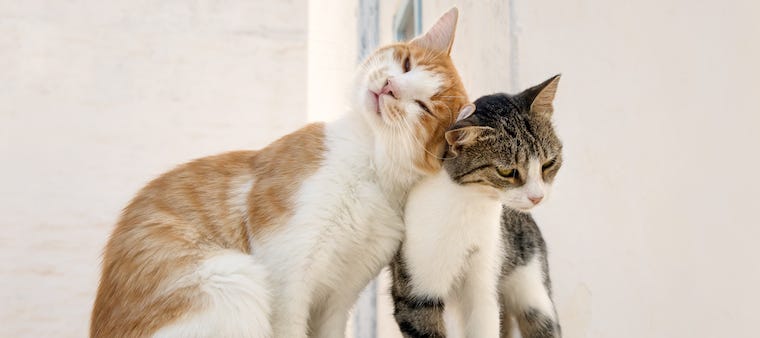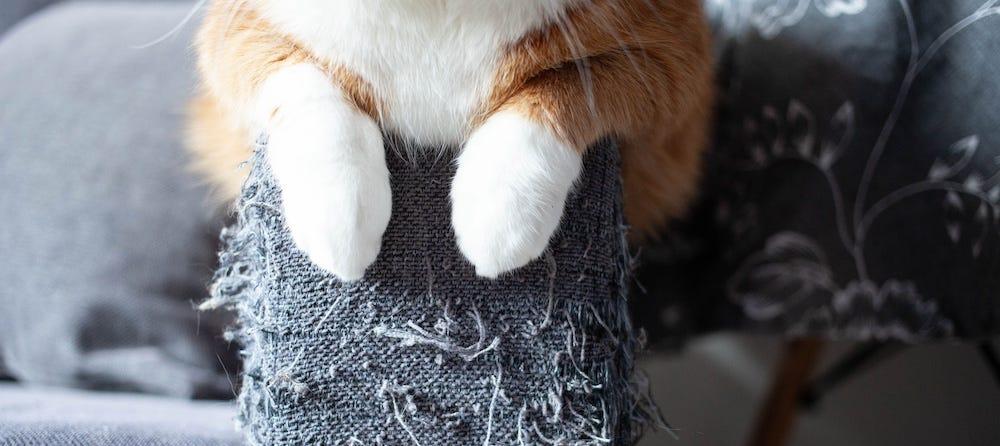Written by Joey Lusvardi, Certified Cat Behavior Consultant at Class Act Cats
When people bring home a cat, they expect them to be part of the family for the rest of the cat’s life. As anyone who works in an animal shelter will tell you, this too often isn’t what happens. According to the ASPCA, as many as 3.2 million cats are surrendered to shelters each year. Despite shelters’ best efforts to make sure the cats in their care are supported, being in a shelter can be extremely stressful for cats as they await going to their new home.
Rehoming is a huge problem for not only the cats, but the humans involved as well. Cat parents may struggle with feelings of guilt or shame about what is no doubt an emotional choice to make. Shelter workers and volunteers may not have the resources to take care of all the cats. This leads to stress, compassion fatigue, and burnout.
Given the negative impacts on all species involved, it’s important that the decision to rehome a cat is taken seriously. There are a lot of things to consider and often the decision is made while under emotional distress. While I am in no way advocating for rehoming being the first choice folks make, there are actually some situations where rehoming a cat is the kind thing to do. How can you decide if you should rehome your cat? Let’s look at all of the ethical considerations of rehoming a cat along with what to do if you conclude it’s the right choice for your situation.

Reasons for rehoming a cat
As a certified cat behavior consultant, I hear the full range of reasons why people have rehomed a cat or are considering rehoming their cat. Common themes I’ve heard from clients are behavior problems in the cat, changes in life circumstances for the humans, medical problems in either the cat or human, and incompatibility between multiple cats in a household.
A 2018 study conducted by the National Council on Pet Population Study and Policy found that the single biggest reason people cited for rehoming pets was too many animals in the home. Other common reasons for rehoming included issues related to:
- housing
- financial strain
- litter box problems
- conflict between pets in the home
A 2015 study by the ASPCA looked at other reasons for rehoming: they found that just over half of rehoming was due to reasons unrelated to the pets themselves. Even among folks who rehomed their pet due to a problem directly related to the animal, in a quarter of the cases, the reason was being unable to afford veterinary care. While it may seem like the animal’s health is the reason for the rehoming, it’s ultimately the human’s financial status that is the problem in these cases.
The effects of rehoming on cats
Cats fill a weird ecological niche as both a predator and a prey species. Because they are sometimes prey for other animals, cats are always on the lookout for sources of danger and prefer a consistent environment. While tolerability for change varies among individual cats, even small changes in their home or routine can be incredibly stressful for cats.
If small changes are bad, it’s not much of a stretch to conclude that completely changing the cat’s environment is even more stressful. Cats really don’t like change! Say a cat is brought to a shelter environment: The cat isn’t going to understand why they are suddenly in a new place, potentially with a whole bunch of other cats or unknown humans. They may not get as much attention as they need and be confined to a small space all day. It’s a lot for them to go through.
When the cat is (hopefully) adopted after a few days, weeks, or months, their routine is disrupted again. Once more, they’ll need to adjust to a new space with new people. Even if those people are very loving and the space is filled with everything cats love, this change may not be easy on the cat. Rehoming is inevitably confusing and stressful for most cats no matter how well things go. Their whole life is uprooted not just once, but (at least) twice. It’s a lot for a cat to go through!
When does rehoming make sense?
Looking at the amount of stress rehoming causes the cat, you’d think initially that rehoming should never be an option. Like many things with cats, it’s not quite that simple. While I am in no way suggesting that rehoming should be the first thing one does, there are a few situations where it is the kindest thing you can do for your cat.
There are many factors in deciding if rehoming makes sense. You can start by asking yourself a few questions:
- Is the problem something that can change?
- Do you know how to change it or is there someone who can help you change it?
- Do you have the resources or ability to make changes to address the problem?
- Is keeping your cat in their current environment going to be more stressful than finding them a new home?
Is the problem something that can change?
For example, if the reason for wanting to rehome is that your cat is scratching your furniture, that absolutely can be resolved. It really isn’t fair to your cat to rehome them and put them through that much stress if it’s a manageable fix! On the other hand, if the reason you’re considering rehoming is a serious allergy that isn’t resolving even after working with your healthcare provider for treatment, that’s not something you can change. In the second case, rehoming becomes a more reasonable solution.
Is keeping your cat in their current environment going to be more stressful than finding them a new home?
Looking at the needs of the cat, you have to do a risk-benefit analysis to determine if the stress of rehoming outweighs the stress of them staying in their current environment. Let’s look at an example of a cat displaying an unwanted behavior: In a lot of cases where I am hired, the problem ends up being a lack of cat-specific resources. Adding something to the home like Whisker’s Cat Tower that not only adds vertical space for your cat to climb, but has a place for the cat to scratch can easily meet multiple of your cat’s needs. In this case, the stress of rehoming would not be outweighed by the benefit of a new home when a pretty simple change can address the cats’ needs.
Do you have the resources or ability to make changes to address the problem?
In a different situation it may be more challenging or impossible to make a change to the environment to address the problem. For example, if your home isn’t big enough for the number of cats you have, moving may not be practical or possible. You could try environmental modification to add more resources for the cats, but getting cats to stop fighting is very hard. If you simply don’t have the space to make it work, the stress of rehoming may be less than the stress of keeping one or more of the cats in an environment where they are constantly antagonized. In the end, the change may be better for your cat.
Alternatives to rehoming a cat
Before jumping to rehoming, especially if you aren’t sure it will be beneficial for your cat, it’s a good idea to take a few steps to attempt to resolve the issue. If finances are a problem, you may want to look into local organizations that can supply free food to low-income pet parents. There may be places to seek out low-cost veterinary services or you may be able to arrange a payment plan with your veterinarian.
If the problem is behavioral, you can try taking advantage of some of the great cat behavior resources out there such as iCatCare. You may be able to figure out the problem on your own. If you aren’t able to do so or want some extra help, bringing your cat to the veterinarian or working with a behavior consultant may help you figure out a solution. They can also help you make a decision regarding rehoming and discuss what is the best choice for your cat.
If your situation involves multiple cats, you could consider setting up a time-sharing situation where you divide up your home so each cat gets time with the humans. This involves swapping the cats out without seeing each other at all. This allows the cats to spend time with their humans while not being as stressed out by seeing each other. Depending on the size of your space, it may be possible to divide your home in a way where each cat can have a nice space on whichever side they’re on.

How to rehome a cat responsibly
If you’ve tried fixing the underlying problem or it’s clear that keeping your cat in your home is going to be more detrimental than finding them a better environment, rehoming may be the next best step. There are right and wrong ways to rehome a cat—you’ll want to think the process through so your cat can have the best chance of a successful transition.
Never abandon or release your cat outside
Even if you’re desperate to find the cat a new home, abandoning your cat or releasing them outside is never the solution. This puts your cat at the risk of injury or death. Especially if your cat is an indoor-only cat, they may not be able to survive outdoors. Cats are living creatures, not objects, so you have a responsibility to them to help them get to a better situation.
Look for a no-kill rescue or shelter
Many people surrender their cat to a rescue or shelter. You’ll want to thoroughly research wherever you bring your cat, as there is a wide range in quality of rescue organizations. If your cat doesn’t like other cats very much, you may want to focus on foster-based rescues. If your cat is older or has a medical condition, try to find an organization that specializes in older or medically complex cats. Make sure that wherever you take your cat is reputable and that your cat will be well taken care of while there.
Be cautious with message boards and friends
Some people will rehome using online message boards or through personal acquaintances. While this can work out, you’ll want to be careful with this approach. Unfortunately, there are a lot of people who take cats without good intentions or understanding the responsibilities involved. The home your cat may be going to may not be a good fit, or could even be a bad environment. You’ll want to thoroughly screen any prospective adopters. While not a perfect solution, consider asking for a rehoming fee to reduce the chances of someone with nefarious intentions adopting your cat. This can be a lot of work, so going through a rescue is often the easier and safer choice.
Provide the right info and items
Regardless of how you rehome, you’ll want to gather information about your cat’s history including dietary preferences, medical records, behavioral records, and anything else that may help a new owner decide if your cat is a good fit for them. Giving this information to the shelter or rescue can help them find a new home that works out better. Consider sending some of your cat’s favorite items with them so they have objects with their scent on them while in the shelter. This can help ease the transition.
Make the responsible choice
If you have multiple cats, part of rehoming responsibly is deciding which cat gets rehomed. If two of your cats are bonded, it may be helpful to rehome them together, as it will be less stressful for both cats to not lose the other cat. You also will want to consider how easy it may be for each cat to get adopted. For example, if you have an older cat who you have had for years who is not getting along with a new kitten, the kitten is much more likely to be adopted. Even if you may want to keep the kitten, think of how much the older cat may be affected by being sent to a new environment. They may even be stuck in the shelter for a large portion of their remaining time. That’s not fair to them!
Be patient
Most importantly, the cat is still your responsibility until they are in their new home or with the rescue organization. You still need to take care of their needs, even if you’re frustrated with them. Remember, rehoming is going to be stressful on your cat. You owe it to them to take care of them until they are no longer under your care.
Regardless of what you decide to do, the decision to rehome is not one to take lightly. Rehoming a cat is a big deal and can create a lot of stress for the cat (and likely for you, too!). However, it’s not always a bad thing. If it’s genuinely in the best interest of your cat, it may be the right choice to make.
About the author: Joey Lusvardi is an IAABC Certified Cat Behavior Consultant based out of Minneapolis, MN and founder of Class Act Cats. He helps cat parents with addressing behavior concerns, cat training, and more. He holds a certificate in feline inappropriate elimination and is a Fear Free Certified Professional. Joey is available for consultations virtually wherever you are located or in person in the Twin Cities metro area.
Sources:







